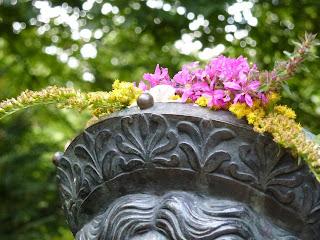At the moment I'm writing an essay about the garden of Schloss Charlottenburg in Berlin.
I read a lot about this theme complex (even, for the first time in my life, an 'historical novel' about Sophie Charlotte (1668 - 1705), who begged for this garden - quite amusing to see that King Friedrich I. ('Sloping Fred') always sent her a mounted messenger with a red velvet cushion when he wanted to visit her in a special mission.
But I digress. What I will write about is my discovery that sometimes you only see something when someone else has mentioned it. At least I. How many times I have been in that park, looking attentively, always joyous because its very special width has a betwitching impact on the light; the beautiful canvas of the sky often gives his performance as Italian light blue charmer.
But never had I discovered the bust of Queen Luise (not even, I am ashamed to confess, the little Luisen-island, which 1799 was ordered by King Friedrich Wilhelm III - and when I finally found it, it took my three visits till I discovered the bronze bust - very well hidden behind a sitting place with benches and bushes). This confession will make the ardent worshippers of Queen Luise hoot with derisive laughter. Oh yes, she still has a wide group of devotees (one is an aquaintance of ours, living in Hannover, whose house is brimming over with very precious antique devotional objects - a bit surprising to me, but very charming).
But back into the park: I learned that sometimes one has to know what to look for - only then you will follow your quest and not despair till you find it, knowing in your heart: it must be there!
As it was. Added by a big surprise: somebody had adorned it!
That devotion - so simple, but so gorgeous! - brought a smile to the somewhat sad features of the queen.
And it was done with style, simplicity and a keen sense of beauty.
Look:



I had no knowledge of Queen Luise, so went to look her up. This is what stood out in what I read: she had 9 children and died at age 34. How did she even have time for anything else?
ReplyDeleteDear Sue,
ReplyDeletethey married so early, and then, married for 17 years, 7 of her 10 children reached the age of grown-ups - but to have so many children was even at those times remarkable.
I wondered about the same as your question when I stood in Hampton Court and read about the wives of Henry - the only aim was to bear a heir to the throne.
Aren't we lucky today?
Thank you for these excellent photos. The garden bust of Queen Luise shows a strong, pretty face and, if I imagine her eyes, there might have been mischief in them. I know there has been a great deal of public enthusiasm in memory of her, but my impression focuses on the ingredients of tragedy. Had she shared her husband's views on pacifism, perhaps her life would have been easier. Despite my ambivalence, I consider her a very remarkable person.
ReplyDeleteDear Geo.,
ReplyDeletethank you - I love especially the first photo with the opposition of dark bronze which hightens the colour of oh so fresh nature's berries.
As to Luise: I don't know very much about her - Napoleon said that she was guilty for the start of the war, „a woman with a pretty face, but little brains" - I only know that she said as a young girl: "Might God prevent me to cherish my brains and neglect my heart", she would prefer to throw "all books into the Havel" than put sense higher than sensibility. Well - being young might be her excuse.
Why there are still afficionados of her today: I have difficulties to understand that - Prussia is gone, France is a friend and no longer a foe, and women are very different today (I hope :-)
Nothing against vanity, or sensibility - but sense is important too.
The bronze statue decorated with flowers creates a striking image, but what strikes me even more is that someone cared enough about her to put them there. The study of history (at least in the U.S.) is woefully insufficient, so I find it intriguing that people in your country not only know of this queen who lived centuries ago, but still hold her in such high esteem. It's quite remarkable.
ReplyDeleteDear Susan,
Deleteinterest in history is quite intense in Germany, though in the case of Queen Luise's worshippers I guess that they might be from the wide range of "fans" (one of the topics that husband, as professor of popular culture, researches). I think she might be an idol for (some) bourgeois citizens, more sophisticated than cheering Madonna :-)
What a beautiful discovery Britta. The adornment of Queen Luise is so elegantly and delicately arranged, it makes the most beautiful photograph.
ReplyDeleteDear Paul,
Deletethank you! I will try to find out if it is done more often (and, always being curious about people: who does it). .
Nice to know there are new discoveries to be found, even in our most visited spots. Lovely.
ReplyDeleteDear Janet,
ReplyDeletein your wonderful garden that is so huge I think the same will happen every day: you often show us discoveries - a plant you didn't see before, a bird or insect we want to know the name of. Always enticing!